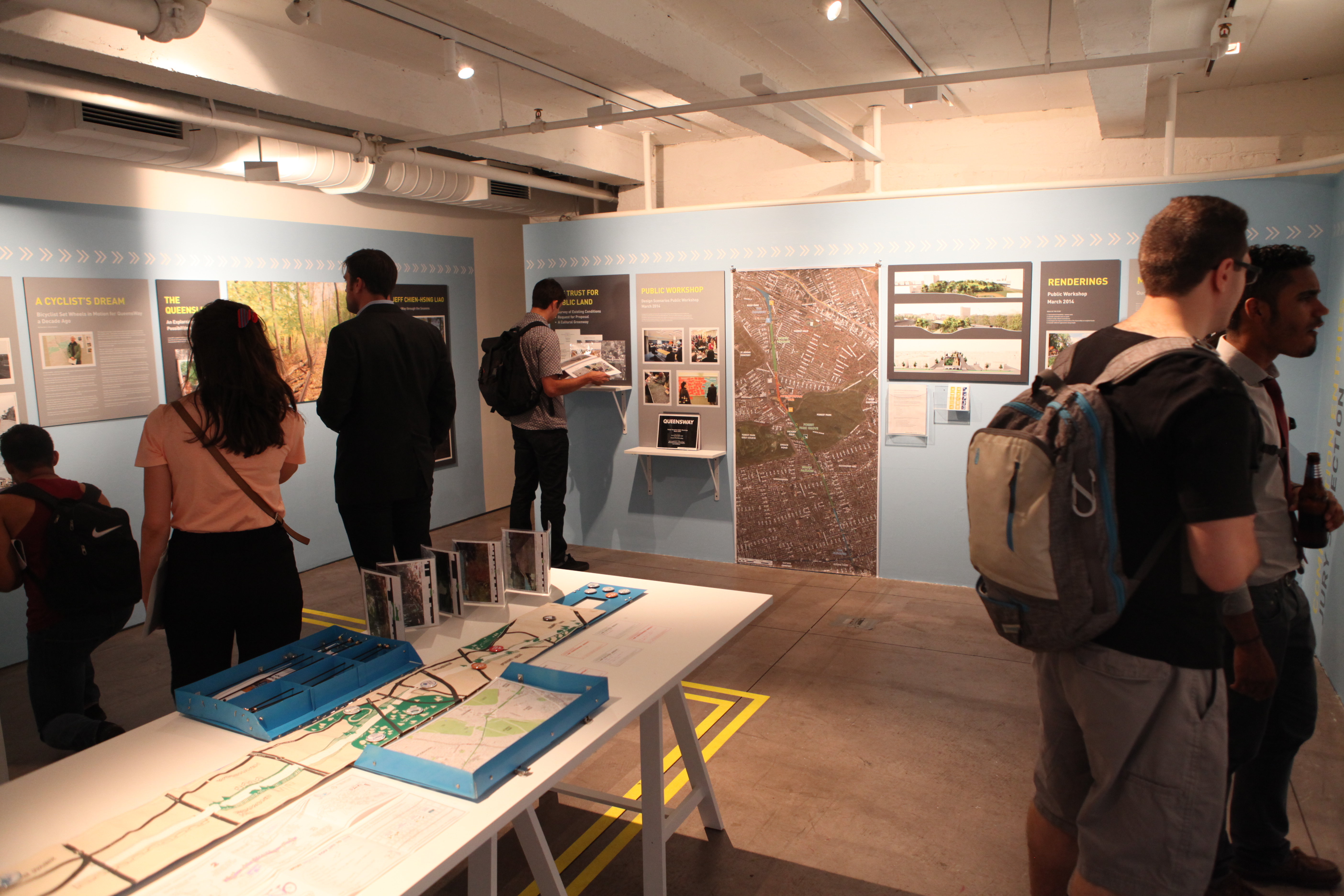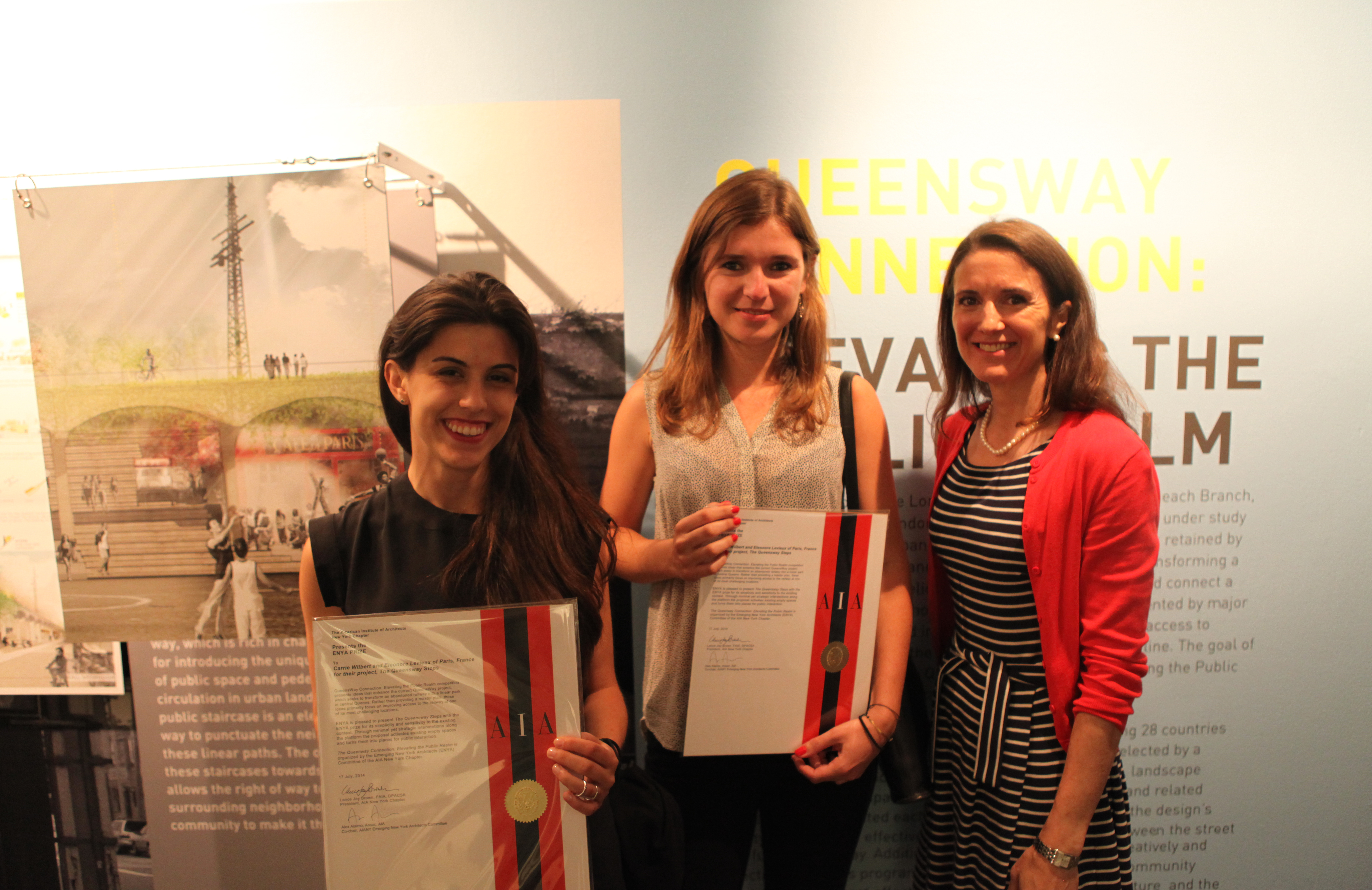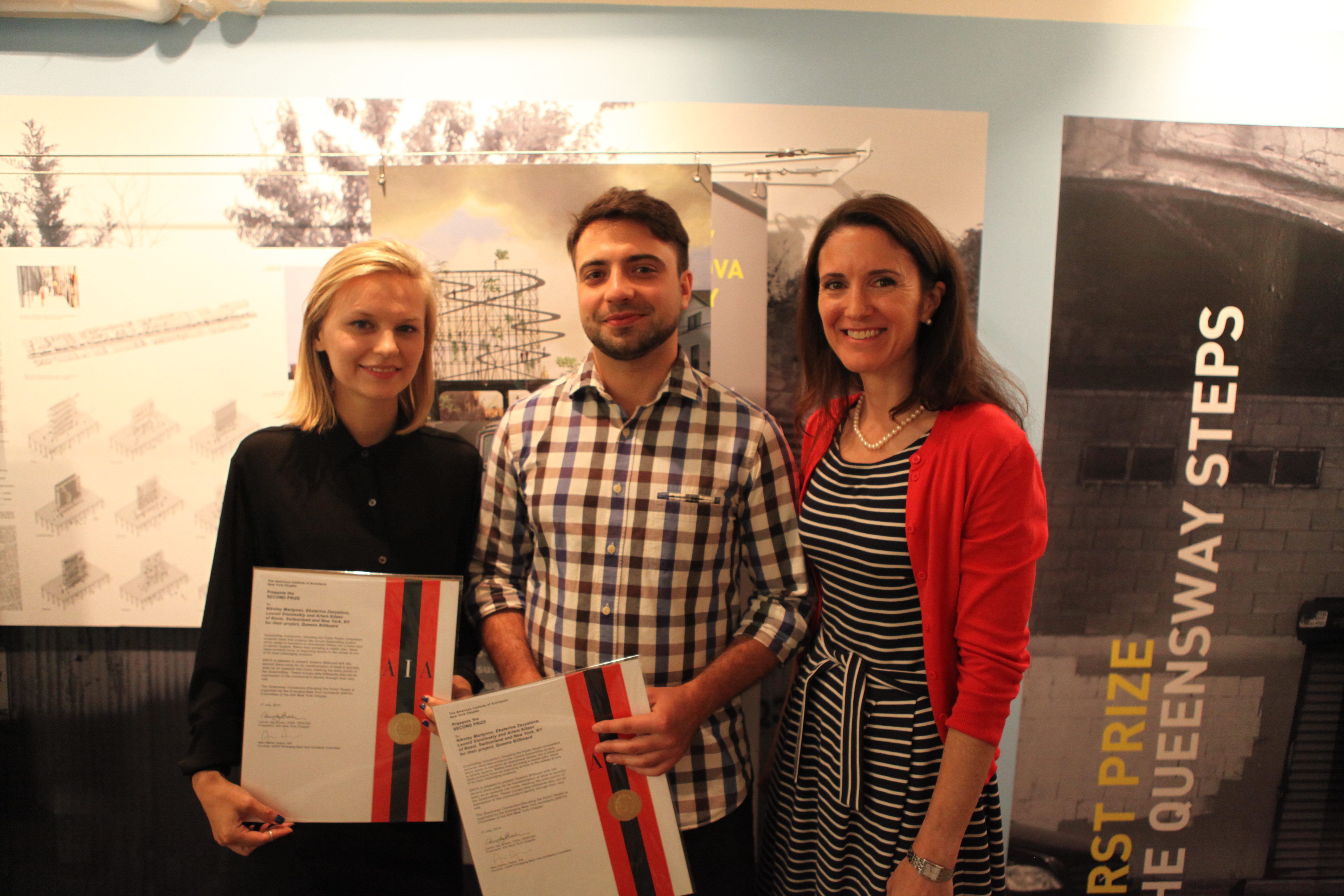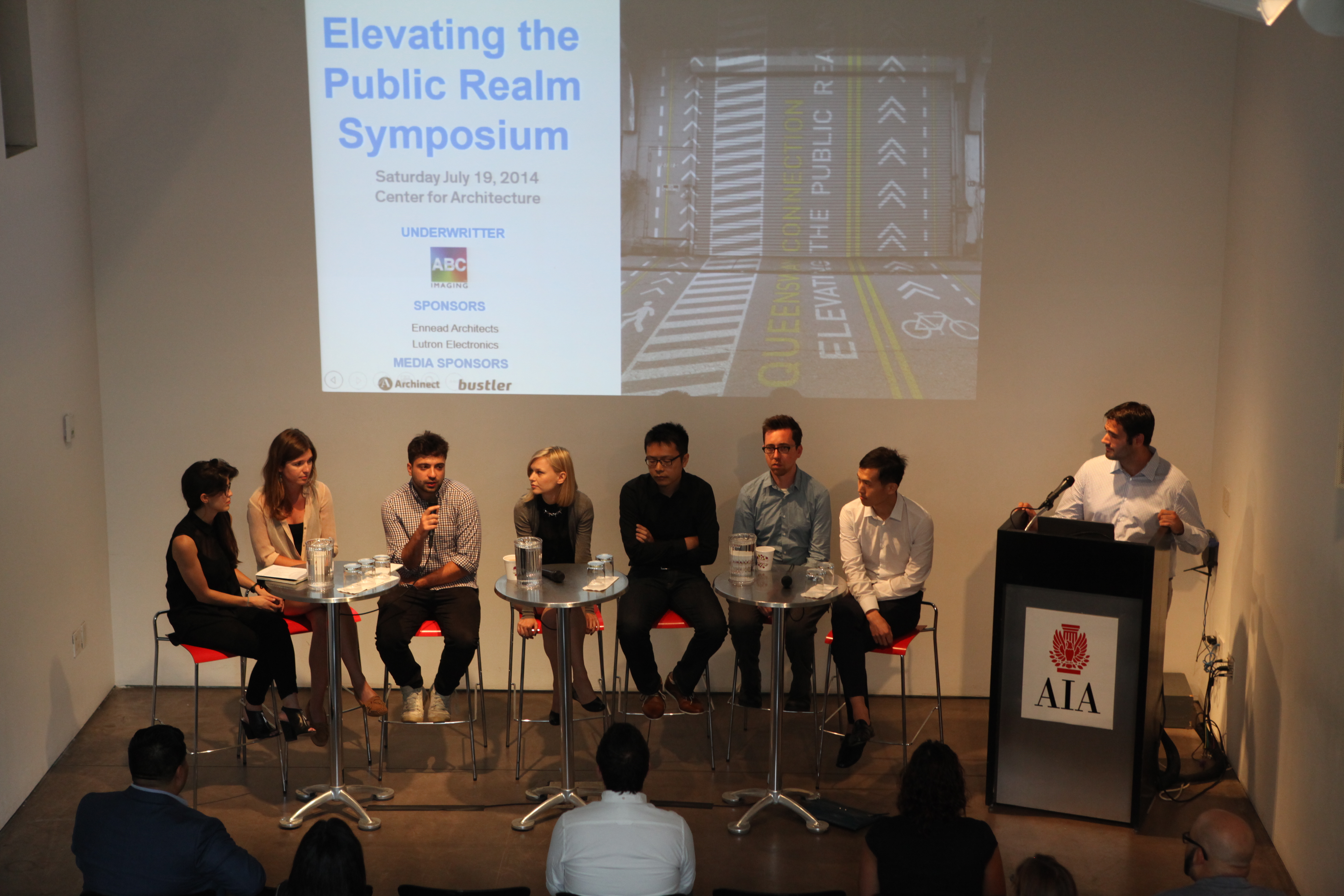by: Graham Higgins LEED AP
On 7.17.14, the Center for Architecture opened its doors to the “QueensWay Connection: Elevating the Public Realm” exhibition. The installation’s opening and symposium two days later, organized by AIANY’s Emerging New York Architects Committee (ENYA), reaffirms the significant opportunity a 3.5-mile stretch of abandoned railway presents for both Queens and the City of New York. ENYA, which hosts a biennial design ideas competition focused on elevating the public realm, is in full support of the collective efforts of the Friends of The QueensWay community organization and the Trust for Public Land in the development of the QueensWay linear park. Through the adaptive reuse of an extant railway, the QueensWay is poised to become a catalyst for economic growth, environmental stewardship, and community development within Central Queens. ENYA’s Queensway Connection: Elevating the Public Realm Competition further substantiates this opportunity to transform a blighted, disused structure into a civic amenity and an iconic park.
The QueensWay Connection competition was an unquestionable success, receiving a range of 120 proposals from 28 countries. Each one of the competition’s winning submissions focused on the importance of encouraging community participation through effective design. The first-place winning proposal, The QueensWay Steps, promotes public mobility through the reactivation of the formerly isolated railway, and the creation of a web of distinct connections to existing communities. The winning team, led by Carrie Willbert of Paris, France, cited Rome’s Spanish Steps as a distinct inspiration. Like the Spanish Steps, The QueensWay Steps present the Queensway as a destination rather than merely a connection. The project envisions the abandoned railway as an opportunity to reactivate disused industrial spaces adjacent to the structure, integrating isolated elements into a coherent whole that celebrates Central Queen’s current character. Each of the competition’s submissions served to further substantiate the potential in transforming the neglected into the exceptional.
The QueensWay has continued to receive a steady stream of press, including a recent New York Times OpEd, illustrating the railway’s potential as a platform to display Central Queen’s multicultural identity through local food vendors. It is increasingly clear that a thoughtfully designed linear park will serve as a civic amenity and augment one of the city’s most culturally diverse neighborhoods. ENYA’s QueensWay Connection exhibition and symposium, in particular, solidified the range of benefits the park presents. Symposium speakers stressed the significance of this unique would-be park by demonstrating the array of benefits applicable across local and city scales. The proposed site, currently being studied via a $467,000 grant funded by the New York State Office of Parks, Recreation and Historic Preservation, reveals the potential of adding 47 acres of park space to Central Queens. This area is currently severely underserved by green space, with less than one-tenth of the city’s recommended 2.5 acres per 1,000 residents. Increased green space offers a series of benefits, including public health by encouraging more active lifestyles, stress reduction, lower crime rates, safer neighborhoods, and educational opportunities. As nearly 250,000 New Yorkers, roughly the population of Buffalo, live within a 20-minute walk of the QueensWay, these benefits have the potential to generate new park space, as well as provide opportunities to catalyze economic development and job creation, support local small businesses, and improve environmental conditions. The Queensway not only offers the benefits traditionally associated with urban green space, but also provides the opportunity to link communities more effectively to existing green space, and create more sophisticated biking infrastructure to increase visitation.
The key to the Queensway’s success is effective community engagement. The project lies at the forefront of contemporary urban design trends that seek to engender grassroots support as a platform for success. While the Queensway bears similarities to a variety of globally significant linear parks, such as Chicago’s The 606 (formerly Bloomingdale Trail), Paris’s Promenade Plantée, and most notably New York’s own High Line. It is crucial to acknowledge the Queensway’s unique context and character with its unique levels of density and cultural diversity. While it is difficult to isolate a single variable that led to the High Line’s success, it is clear that the project’s champions Robert Hammond and Joshua David, and their locally-derived enthusiasm, transformed an effort to preserve a derelict railway into one of New York’s most popular attractions. The Queensway’s future success is contingent upon inspiring similar support and continuing to illustrate the railway’s dormant potential. Great works of urban design harness the unique character of their sites while also reflecting broader societal trends and goals. The Queensway illustrates the community’s central role in the design process and the reuse of infrastructure’s revitalizing influence.
The competition’s five finalists:
1st – Queensway Steps – Carrie Willbert and Eleonore Levieux, Paris, France
2nd – Queens Billboard – Nikolay Martynov, Basel, Switzerland
3rd – Song Deng and René Biberstein, Toronto
Student Prize – EBB and Flow – Jessica Shoemaker, Albuquerque, New Mexico
Honorable Mention – Upside Down Bridge – Hyuntek Yoon, Queens, New York
Event: Exhibition Symposium | QueensWay Connection: Elevating the Public Realm
Location: Center for Architecture, 07.19.14
Speakers: Andy Stone, NYC Director of The Trust for Public Land, and ENYA QueensWay Connection Competition Juror; Ivan Mrakovcic RA, Friends of the QueensWay Steering Committee, and Community Board 9; Karen Kubey, Institute for Public Architecture; Carrie Wilbert, ENYA Prize, The Queensway Steps, Paris, France; Nikolay Martynov, Second Prize, Queens Billboard, Basel, Switzerland; Song Deng and Rene Biberstein, Third Prize, Make It! Grow It!, Toronto, Canada; Hyuntek Yoon, Honorable Mention, Upside Down Bridge, Long Island City, NY, USA
Organizers: AIANY Emerging New York Architects Committee (ENYA)
Sponsors: ABC Imaging (Underwriter), Ennead Architects, Lutron Electronics (Sponsors), Archinect, and Bustler (Media Sponsors)











